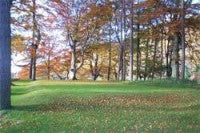Selecting shade tolerant turf grass species for sports stadium pitches
Selection of shade tolerant turf grass species for sports stadium pitches

Shade has become a significant factor in the maintenance of natural turf playing surfaces particularly in stadium environments; most stadium managers are now aware of the problems shade can cause. The continued demand for improved stadium facilities allowing spectator comfort has increased seating capacity. The building of larger stands and the infilling of the corner areas of these stadiums reduces air flow and light levels being received by the grass plant.
The recent announcements in the news regarding both Twickenham and Wimbledon having major stadium redevelopment to increase seating capacity and covered roofing will undoubtedly increase the problems of shade in those arenas.
Effects of shade on turf grasses: 
Lack of sunlight is the most important factor affecting shaded turf 'but it's often not the only one'. Most turf grasses evolved under sunny conditions and cannot easily adjust to low light levels. Wind speed and temperature are affected by shade, too. Shaded sites almost always have lower wind speeds than sunny areas. All these factors have an influence on the grass sward quality and growth.
However the main factor that affects the grass plant is the reduction of light intensity and light quality, Sunlight contains photosynthetically active radiation (PAR), which can trigger biosynthesis processes in the plant. When these are effected by lack of sunlight an altered reaction takes place with growth and development resulting in elongated and thinner leaves, reduced density, shallow rooting and lower reserves of carbohydrates thus the grass plant becomes less tolerant to wear, disease and environmental stresses.
 Turfgrass growing in shade generally requires less total nitrogen than grass in full sunlight because of the reduced rates of photosynthetic activity. Over application of nitrogen on shaded grasses reduces stored food reserves and produces thin cell walls. This, coupled with a high humidity state generally found in shaded areas caused by lack of evaporation (Low temperatures and drying winds) around the grass plant results in an environment susceptible to disease pathogens.
Turfgrass growing in shade generally requires less total nitrogen than grass in full sunlight because of the reduced rates of photosynthetic activity. Over application of nitrogen on shaded grasses reduces stored food reserves and produces thin cell walls. This, coupled with a high humidity state generally found in shaded areas caused by lack of evaporation (Low temperatures and drying winds) around the grass plant results in an environment susceptible to disease pathogens.
With the grass plant already under physiological stress, the activity of sport will contribute to a weakened sward resulting in high areas of wear and thinning out of the grass cover especially in the shaded areas of the pitch.
Turfgrass management:
The main role of effective grass management is to keep the grass healthy and vigorous preventing further deterioration of the grass sward in shade.
|
Strategies for managing turf in shade: Table 3.1
|
|
Selection of grasses for shade:
Turf in shaded sites requires different management practices than turf in full sun. Understanding differences between sun and shade environments and the maintenance required to maintain optimum plant growth will help in choosing the appropriate grass seed mixture for the situation. 
Issues that will influence the choice of turfgrass species for the sports stadium are
Climate, soil type, wear tolerance, colour, mowing requirements (height, frequency), fertiliser needs, density, Irrigation needs, and drought tolerance grass species normally recommended for rugby / football pitches are Perennial ryegrass (Lolium perenne L.) tufted growing habit, its speed of establishment is faster than most other grasses. Smooth stalked meadow grass (Poa pratensis) tolerant to close mowing and wear but slow to establish. Red fescues (festuca rubra spp.) three types, chewing, slender creeping and strong creeping. They all perform well and noted for colour, drought resistance and have the ability to fill in bare areas, using their rhizomes. Bent grasses (Agrostis spp.) 'Highland' (A. castellana) for winter colour but susceptible to diseases, Red thread and fusarium.
Another new shade tolerant grass that has been introduced into seed mixtures is the tufted hair grass (Deschampsia caespitosa) cultivar Barcampsia providing excellent shoot density, a good wearing grass adapted to low temperatures.
Examples of manufacturer's recommended seed mixtures for shaded pitches and other turf grass facilities.
|
British Seed Houses (Supplier) |
British Seed Houses (supplier) |
||||||
|
Grade A7 Olympic sports grounds. Provides excellent shoot density and wear tolerance swards |
Grade A8 Supra sport, (poa supina ) performs well in areas or wear / shade. Fast to establish. |
||||||
|
Mixture sow @ 35g/m2, mow down to 10mm |
Mixture sow @ 35g/m2, mow down to 25mm |
||||||
|
% 30% 25% 15% 25% 5% |
Species Lolium perenne sp. Lolium perenne sp Poa pratensis sp. Festuca Rubra ssp.commutata Agrostis castellana |
Cultivar Aberelf Darius Julia Olivia Highland |
% 45% 40% 5% |
Species Lolium perenne sp. Lolium perenne sp Poa supina |
Cultivar Aberelf Aberimp Supra |
||
|
Barenbrug UK (Supplier) |
Barenbrug UK (Supplier) |
||||||
|
BAR 7 - Football and Rugby renovation, sports pitches, racecourses, polo pitches Bar 7's rapid establishment and wear tolerance is unrivalled. Barlinda is the only perennial ryegrass producing pseudo-stolons, giving rapid recovery from damage. |
BAR SHADE - For areas under shade, such as trees, fences and building surrounds. A specialist mixture formulated to cope with shade and the associated problems with such areas. Developed from Barenbrug's own research programme on the problems associated with shade |
||||||
|
Mixture sow @ 30 - 40g/m2, mow down to 20mm |
Mixture sow @ 25-30g/m2, mow down to 25mm |
||||||
|
% 40% 15% 15% 30% |
Species Lolium perenne sp. Lolium perenne sp Lolium perenne sp Lolium perenne sp |
Cultivar Barlinda Verdi Concerto Romance |
% 40% 40% 20% |
Species deschampsia caespitosa Strong creeping red fescue Hard fescue |
Cultivar Barcampsia Salsa Bardur |
||
|
Rigby Taylor UK (Supplier) |
Rigby Taylor UK (Supplier) |
||||||
|
Mascot R11 - Football and Rugby. Extremely high wear tolerance under high or low nutrient programmes with rapid establishment and good winter colour. A blend of fine to broad leaf cultivars that provides a close knit sward and good playing characteristics. |
Mascot R116 - Shade Renovation. Greenway included for fineness of leaf density and ability to grow at low temperatures. Coupled with symphony to provide dense growth early and late season. High shade resistance reduces stress and increases sward density during autumn, winter and spring. |
||||||
|
Mixture sow @ 35g/m2, mow down to 25mm |
Mixture sow @ 30g/m2, mow down to 4mm (summer) 8mm (winter) |
||||||
|
% 40% 40% 20% |
Species Lolium perenne sp. Lolium perenne sp Lolium perenne sp |
Cultivar Greenstar Greenway Eden |
% 5% 15% 15% 25% 32.5% 5% 2.5% |
Species Lolium perenne sp. Lolium perenne sp. Slender creeping red fescue Slender creeping red fescue Chewings fescue Browntop bent Creeping bent |
Cultivar Ace Greenway Symphony Helena Calliope Egmont Bueno |
||
The above seed mixtures have been put together to maximise the ability of the sward to perform in stadium environments, provide vigour, colour and withstand wear. The performance of these grasses along with many others can be seen in the Sports Turf Research Institutes (STRI) Turfgrass seed booklet, where cultivars of Lolium Perenne L. Darius, Aberelf and Aberimp score well for shoot density, tolerance of close mowing, summer and winter colour. Cultivar of Poa pratensis, Julia has the highest score for wear tolerance with both Festuca rubra ssp. commutata cultivar Olivia scoring a mid table rating along with Agrostis castellana spp.cultivar Highland.
In summary the combination of correct maintenance operations and choice of appropriate grass species should ensure a firm, level, dense, disease resistant grass sward is produced for stadium environments, providing the quality of surface expected by the players .
